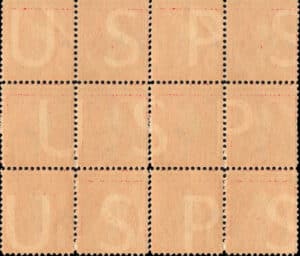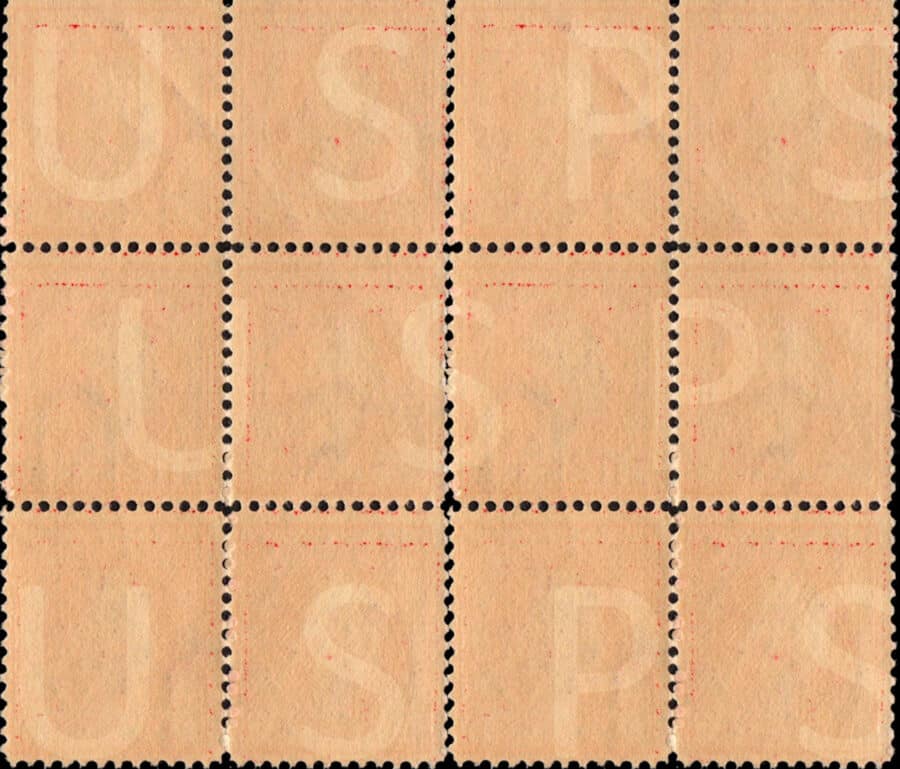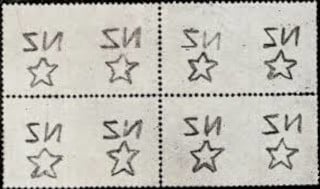Subtotal: €199.95 (incl. VAT)

Watermarks are exactly what you would expect them to be. They are not only important for paper money, but also for stamps. Today we’ll talk shortly about what watermarks are, when they were used for the first time, and how to find them on stamps.
Watermarks are intentionally created thin spots (designs) embedded into the paper of a postage stamp during its manufacturing process. Usually, they can’t be noticed unless you apply certain measure – either it’s holding the stamp up to the light, or something else.
The purpose of watermarks is to prevent counterfeiting. Also, they help us determine the authenticity of the stamp and help us classify stamps.

“USPS” watermark
There are different types of watermarks, but most commonly used are letters, symbols and patterns.
We’re all aware that even minor differences on the stamp could be a sign of some error, and thus indicate that a stamp is rare and more valuable. Of course, the same stand for watermarks. Some were less commonly used; some were not aligned properly. So, this is one more parameter to add when we’re considering stamp value.
“Watermarks are a security measure incorporated in stamp paper to deter counterfeiting. Watermarks may be words, letters or symbols and are formed from dies attached to the frame used to make paper from pulp. The dies result in thin places in the paper.” - https://stamps.org/news/c/collecting-insights/cat/exploring-stamps/post/ap-expertizing-basics-watermarks
The first watermark had been used on the first stamp ever – the Penny Black. Since the introduction of Penny Black was the major change in the postal system, all kinds of measures should be considered and taken into account to be sure new postal system payments will work as expected. Therefore, Rowland Hill proposed that watermarks should be used on the Black Penny.
"Great Britain’s Rowland Hill, in proposing the world’s first postage stamp as part of his proposed postal reforms, was very concerned that the chosen design should be safe from forgery. To this end, the Penny Black, introduced to the world in May 1840, came with superbly detailed line engraving and the provision of individualized check letters for each of the 240 stamps on a sheet – and he required that each stamp should have a watermark" - https://stamps.org/news/c/collecting-insights/cat/exploring-stamps/post/watermarks-a-philatelic-introduction

“NZ” watermark
Watermarks had been pressed into the paper. At the start, this was a manual process, and later the machinery to do the job had been developed.
“Early paper was handmade. It was formed by pressing the pulp into a wire mesh tray-like mold. The Small Crown watermark “bits” were formed of small pieces of brass wire which were bent into the crown shape, and stitched to the flat wire frame in each position. It is here that we now see the pressing of the pulp onto the wire “bit” causing the density variation in the paper that we referred to in the definition of the watermark – all the pulp is still there, but when the removed sheet is dried, the watermark shows as a lighter area.
Astonishingly, each of the Small Crown “bits” was handmade, thus tiny differences arose. These are not readily identifiable, but even in early Penny Black days we see the arrival in the catalogs of watermark errors. For example, the printers inadvertently placed the paper upside down (i.e, wrong end first) on the printing plate, thus “watermark inverted” is listed for nearly all the Penny Black plates, although some are much scarcer than others. More about errors later.
With the success of postal reform and the introduction of stamps, the demand for stamp paper increased dramatically. It was not long before a mechanized means of the paper production took over and with it, when watermarking was required, a mechanized means of applying the watermark to the paper.” - https://stamps.org/news/c/collecting-insights/cat/exploring-stamps/post/watermarks-a-philatelic-introduction
As mentioned, watermarks could significantly impact the stamp value. Therefore, you need a way to find them.
The first option is to try to find them visually, without applying any other technique. If this doesn’t work, you could try using the watermark fluid.
"The fluid is a chemical solvent, and many such fluids are flammable and might have noxious fumes. Keep away from flames, and open some windows when using watermark fluid.
Watermark fluid evaporates quickly, so you have to work fast to match the visible watermark on the stamp to the illustrations of watermarks that appear in stamp catalogs. Some collectors use lighter fluid (naptha) as a watermark fluid. It works, but it does not evaporate as quickly.
No matter what watermark fluid you employ, use tongs to remove the stamp from the watermark tray and place it face down on blotting paper or a paper towel. Let it dry completely before mounting the stamp in an album or placing it in a stock book.
There are electric watermark detectors that use lighting from the side and/or the back to show a watermark.
The electric watermark detector is by far the most expensive option, but it has additional advantages of bringing out flaws that might occur on stamps, such as repairs, creases and thins, though some of these can be seen with the watermark fluid as well." - https://www.linns.com/insights/check-watermarks-to-make-sure-you-ve-got-the-right-stamp.html
Of course, you can always try some “home medicine”, as described in this video:
Today we’ve seen a brief introduction info watermarks in philately. While you wait for the next article, I suggest that you take a look at 2 interesting articles more closely related to the “philatelic theory”.
Continue Reading
10 Most Useful Websites to Find Your Stamps
Colour Guides for the Stamp Collectors: Shades & Tones in Stamps









